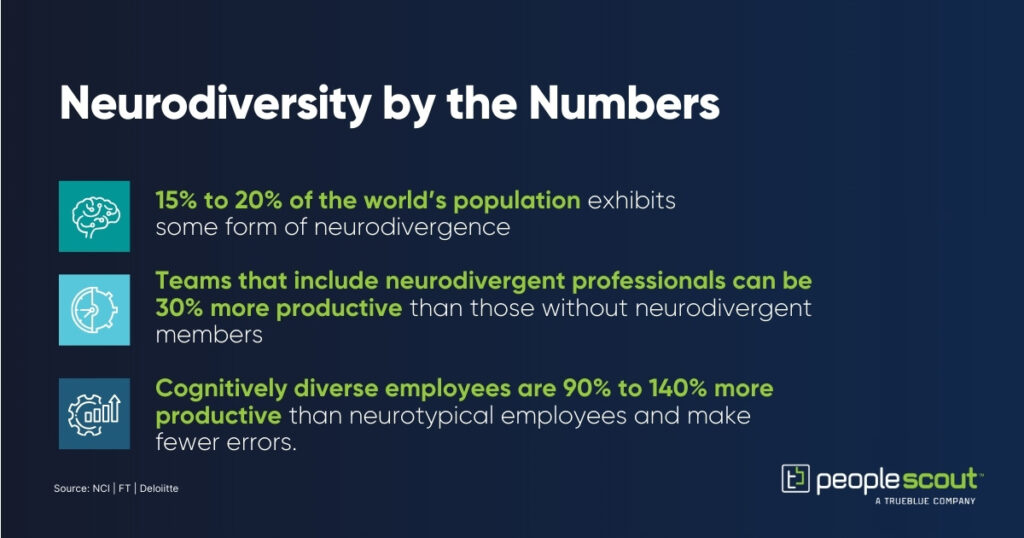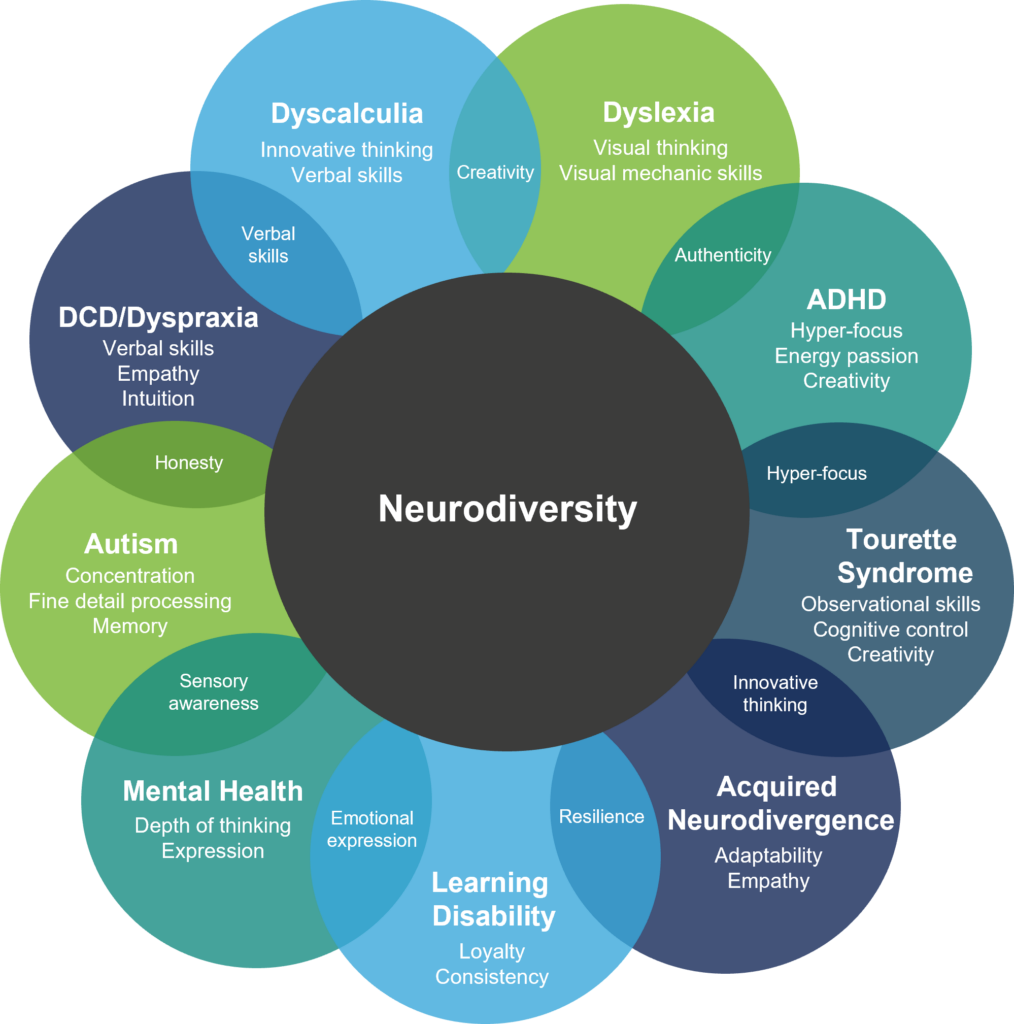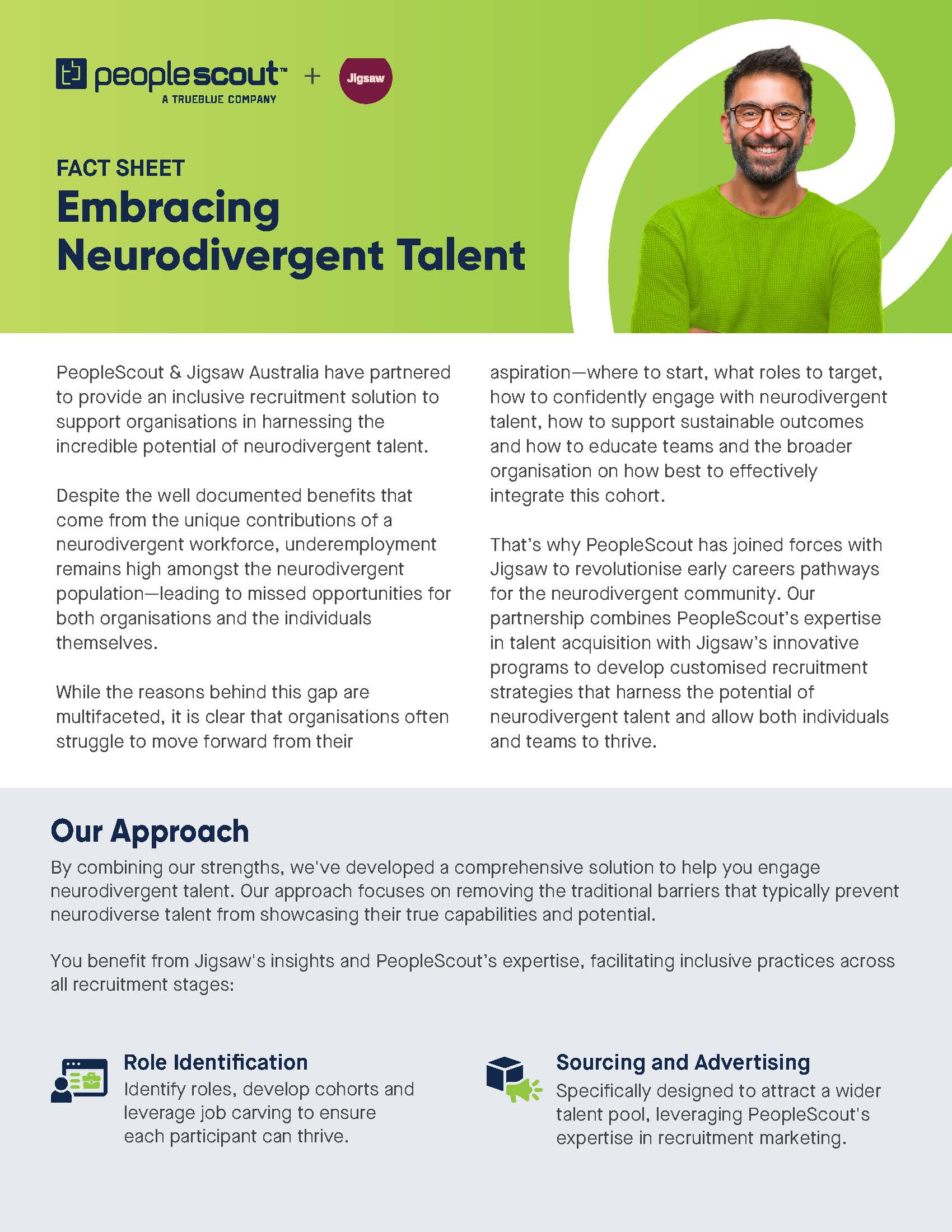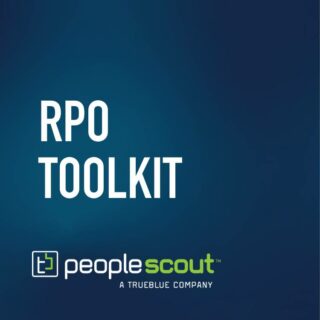Neurodiverse recruitment unlocks a wealth of unique strengths, offering employers access to exceptional skills in pattern recognition, analysis, mathematics and beyond. This approach to hiring isn’t just inclusive—it’s a catalyst for innovation. By building cognitively diverse teams that blend neurodivergent and neurotypical talent, organizations supercharge their creativity, decision-making and problem-solving capabilities. The result? A dynamic workforce that drives efficiency and innovation to new heights.

The untapped potential of neurodivergent talent is staggering, with alarming underemployment rates that rob both candidates and companies of incredible opportunities. In the U.S., it is estimated that as many as 85% of college-educated autistic adults struggle with unemployment. The Office for National Statistics (ONS) paints an equally grim picture for the UK, with just 21.7% of autistic individuals employed. In Australia, 70% of new starters with disabilities do not survive the probation period, while 65% of Australian businesses remain unsure about how to access this rich talent pool.
While many organizations aspire to build a workforce that harnesses the potential of the neurodivergent community, few achieve this goal. While the reasons behind this gap are multifaceted, there’s a critical knowledge gap about neurodiversity in the workplace and how to create neuro-inclusive hiring processes.
Ready to move the needle on neurodiverse recruitment? Let’s dive into five strategies that will transform your hiring process and unlock the full potential of neurodivergent talent.
What is Neurodiversity?
First, let’s define what we mean by neurodiversity. Neurodiversity refers to the concept that everyone experiences and interacts with the world around them differently. A neurodivergent person’s brain may work in a different way than the average “neurotypical” person. They may have unique ways of learning, communicating, working, socializing or perceiving their surroundings.
While neurodiversity is often used in the context of autism spectrum disorder (ASD) and Asperger’s syndrome, many conditions fall under the neurodivergent umbrella, including ADHD, dyslexia, dyspraxia, Down syndrome, Tourette syndrome, and even mental health conditions like bipolar disorder, OCD and social anxiety.

6 Strategies for Neurodiverse Recruitment
There’s no one-size-fits-all solution for neuro-inclusive recruitment, as neurodiversity encompasses a wide range of conditions, many of which may be undiagnosed or undisclosed. The key is to create a flexible process that can be tailored to individual needs.
1. Identify Roles for Neurodivergent Recruitment
To identify roles for neurodivergent talent, companies need to think beyond traditional job categories and focus on the core skills and tasks involved. Analyze and pinpoint positions that require deep focus, pattern recognition or systematic thinking—areas where many neurodivergent individuals excel. Look for roles that benefit from attention to detail, data analysis, quality control or creative problem-solving.
Tech roles often offer a goldmine of opportunities, from software development to cybersecurity. But don’t limit yourself—neurodivergent talent can thrive in unexpected places. Consider positions in finance, research, design or even customer service roles that involve script-based interactions.
You might also consider job carving, which involves customizing job roles by reorganizing tasks to create a new, tailored position that aligns with an individual’s strengths and abilities. This approach not only benefits neurodiverse employees by providing them with roles tailored to their abilities but also helps organizations make the most of their diverse workforce.
The key is to break down jobs into their fundamental components and match them with the unique strengths often associated with neurodiversity. Remember, it’s about recognizing where neurodivergent traits can be a significant asset to your existing needs.
2. Audit the Application Process for Neurodivergent Recruitment
Once you’ve identified roles where neurodiverse talent can thrive, it’s time to audit the application process. Put on your detective hat and scrutinize every step. Is it neurodiversity-friendly, or is it secretly working against you?
First start with the job description. Consider replacing lengthy, jargon-filled job descriptions with clear, concise summaries of the core responsibilities. Embrace inclusive language that speaks to diverse cognitive styles. Think less “excellent multitasker” and more “deep focus on specialized tasks.”
Then, move onto the application itself. Complex, multi-step applications can overwhelm candidates with conditions like ADHD or autism, potentially causing them to abandon the process altogether. Simplify application forms by asking only for essential information. You could even consider offering alternative submission methods, like video applications.
Ditch the requirement for cover letters in favor of skill-based assessments that directly relate to the job. By streamlining the application step, you level the playing field and tap into a rich pool of often-overlooked talent.
3. Communicate Early & Often
Be direct with your language and deliver information in multiple ways. Some candidates will be okay with written instructions, others like those with dyslexia, may receive information better through videos or audio explanations.
Start by providing a clear preview of the entire recruitment journey. Communicate each stage, what the candidate will be required to do and how they’re being evaluated. This transparency benefits all candidates but is particularly crucial for neurodivergent individuals who may need to prepare mentally for each phase.
Maintain frequent, personalized communication throughout the process. Strategic follow-ups can keep candidates engaged and comfortable, increasing the likelihood of offer acceptance. This ongoing dialogue also provides opportunities for candidates to ask questions or request additional accommodations as needed.
4. Balance Assessments & Interviews
Making the interview and assessment steps more neuro-inclusive is crucial for tapping into the diverse talent pool of neurodivergent candidates. While interviews shouldn’t be eliminated entirely, consider balancing them with other evaluation methods.
Shift the focus from traditional metrics to a strength-based evaluation approach. Look for candidates’ unique capabilities and how they align with job requirements, rather than adhering strictly to conventional interview performance criteria. For candidates requiring adjustments, you might weigh interviews less heavily in your overall evaluation, focusing more on practical skill demonstrations or work samples.
When it comes to assessments, large, complex exercises can be overwhelming for some neurodivergent candidates. Break these down into smaller tasks and add in the option to take breaks. Additionally, consider offering extra time for assessments if needed, focusing on the quality of work rather than speed of completion.
A blended assessment approach that incorporates multiple question styles and task types is great option for assessing neurodivergent talent. For instance, at Heathrow we introduced a completely bespoke virtual testing platform called One Experience Assessment (1XP) to recruit for their security officer roles. This included visual “spot the difference” exercises alongside traditional questions, providing a realistic job preview while allowing candidates to demonstrate their skills in different ways.
5. Be Prepared to Provide Accommodations & Adjustments for Neurodiverse Recruitment
Organizations should proactively prepare to provide reasonable adjustments and accommodations for neurodiverse candidates during the recruitment process. Flexibility should be a cornerstone of your approach as everyone has unique needs.
Be prepared to offer extra time for assessments, adjusting standard time limits or breaking longer tasks into manageable chunks. Additionally, be open to changing the location or format of interviews or allowing the use of assistive technology like screen readers during online assessments. Provide interview questions in advance to make the experience more accessible for those who process information differently.
Neurodiverse candidates may experience “sensory overload” in office environments and during in-person interactions. To help candidates better focus on demonstrating their skills and qualifications, design interview spaces with adjustable lighting, offer noise-canceling headphones and provide multiple seating options. These seemingly small adjustments can significantly reduce sensory sensitivity and anxiety.
6. Customize Onboarding & Beyond
Creating effective onboarding programs for neurodiverse employees is crucial for integration into the workplace and their long-term success. Recognize that each neurodivergent employee may have different needs and preferences, and be prepared to tailor the onboarding experience accordingly.
Training is a cornerstone of successful integration. This should be a two-way street, involving both the neurodiverse employee and their colleagues. Provide education and diversity training to managers and team members in advance of or early in the onboarding process. These sessions should sensitively address the characteristics and preferences of neurodivergent individuals, always respecting privacy and dignity. For instance, explain that a colleague with autism might avoid eye contact, helping coworkers understand this isn’t a sign of disinterest. Similarly, managers should be trained on how to introduce neurodiverse team members appropriately, avoiding potentially uncomfortable situations like introductions in large group settings.
Once neurodiverse employees start work, any adjustments offered during recruitment should be available in the workplace as well, ensuring a seamless transition from candidate to employee. By anticipating and preparing for these accommodations, organizations create an environment where neurodiverse candidates can thrive. This may also require implementing flexible working patterns that play to individual strengths. Offering adjustable work hours, remote work options or customized workspaces can help minimize sensory overwhelm.
To further support neurodiverse employees, consider developing growth opportunities tailored to the unique needs of neurodivergent employees. This could include specialized mentorship programs or coaching sessions that focus on leveraging their strengths and navigating workplace challenges. By implementing these strategies, companies can create an onboarding experience that not only welcomes neurodiverse talent but sets them up for long-term success and growth within the organization.
The Importance of Neurodivergent Recruitment
Embracing neurodiverse recruitment is not only a step towards inclusivity but a strategic move that leverages the unique strengths of this group to foster innovation and enhance performance. By closing the knowledge gap and implementing targeted strategies, organizations can create a more inclusive work environment that truly maximizes the potential of all employees, leading to a more dynamic and productive workforce.



